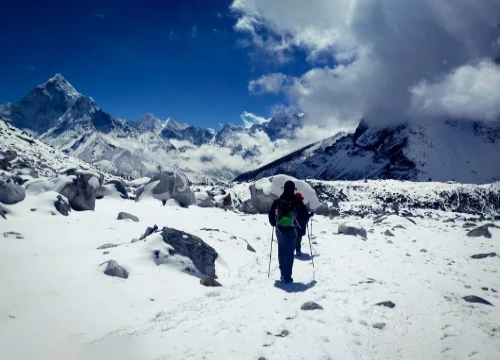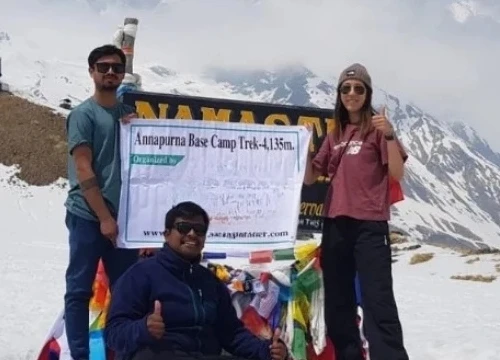As you prepare for the awe-inspiring journey to Everest Base Camp, one question looms large: is Diamox essential for your trek? With breathtaking views and exhilarating challenges, the adventure beckons—but so do the risks of altitude sickness. Understanding how this medication plays a role in your trek can be the difference between a memorable experience and a battle against lack of oxygen. In this article, we'll delve into the practicalities of using Diamox, exploring its benefits, potential side effects, and when you should consider taking it. Whether you're an experienced mountaineer or a first-time trekker, arming yourself with knowledge is key to a safe and enjoyable expedition. Join us as we uncover everything you need to know about Diamox and how it can enhance your Everest Base Camp adventure!
Is Diamox Essential for Your Everest Base Camp Trek
Table of Contents
Understanding Acute Mountain Sickness (AMS)
Acute Mountain Sickness (AMS) is a condition that affects many trekkers and climbers as they ascend to high altitudes. The symptoms can range from mild to severe and can be a real challenge for anyone attempting the Everest Base Camp trek. AMS occurs due to the reduced oxygen levels at higher elevations, which can lead to a variety of physical symptoms. Common signs of AMS include headaches, nausea, dizziness, and fatigue. In severe cases, it can progress to life-threatening conditions such as high-altitude cerebral edema (HACE) or high-altitude pulmonary edema (HAPE). Understanding AMS is crucial for anyone planning to trek to Everest Base Camp, as it can significantly impact the safety and success of your journey.
AMS can strike unexpectedly, even if you are fit and well-prepared for your trek. Factors such as the rate of ascent, altitude reached, and individual susceptibility all play a role in determining who might be affected by AMS. It's important to be aware of the symptoms and to monitor yourself and your fellow trekkers for any signs of illness. Early detection and timely intervention are key to preventing the condition from worsening. By knowing what to look for, you can take proactive steps to mitigate the risks associated with AMS.
One of the most effective strategies for dealing with AMS is acclimatization. Gradually ascending to higher elevations allows your body to adjust to the lower oxygen levels, reducing the likelihood of developing AMS. This process involves spending extra days at certain altitudes, allowing your body to produce more red blood cells and improve oxygen delivery to your tissues. Proper acclimatization can make a significant difference in how well you handle the challenges of high-altitude trekking. However, even with careful acclimatization, some trekkers may still experience symptoms of AMS, which is where medications like Diamox can come into play.
What is Diamox and How Does It Work?
Diamox, also known by its generic name acetazolamide, is a medication commonly used to prevent and treat altitude sickness. It works by helping your body adjust to the lower oxygen levels found at high altitudes. Diamox is a carbonic anhydrase inhibitor, which means it affects the way your kidneys handle bicarbonate and acid. By promoting the excretion of bicarbonate through urine, Diamox creates a mild metabolic acidosis, which in turn stimulates increased breathing and oxygen intake.
The mechanism by which Diamox alleviates altitude sickness is both straightforward and effective. By accelerating acclimatization, Diamox helps to reduce the symptoms of AMS, such as headaches, nausea, and fatigue. It's often used by trekkers and climbers who are ascending rapidly or who have a known sensitivity to altitude changes. This medication can be a valuable tool in ensuring that your trek to Everest Base Camp is not hindered by the debilitating effects of altitude sickness.
Diamox is typically taken before ascending to high altitudes and continued for several days after reaching your destination. The dosage and duration of use can vary depending on individual needs and medical advice. While Diamox is effective for many people, it is not a cure-all and should be used in conjunction with other preventive measures, such as proper acclimatization and hydration. Understanding how Diamox works and the best ways to use it can help you make informed decisions about whether this medication is right for your trek.
The Importance of Acclimatization During Trekking
Acclimatization is a process that allows your body to gradually adjust to the decreasing oxygen levels as you ascend to higher altitudes. This is a critical aspect of high-altitude trekking, particularly for those heading to Everest Base Camp. Without proper acclimatization, the risk of AMS increases significantly, which can jeopardize both your health and the success of your trek. Spending extra time at intermediate altitudes helps your body adapt, reducing the chances of developing serious altitude-related illnesses.
The acclimatization process involves a strategic approach to ascending, often referred to as "climb high, sleep low." This means that during the day, you may hike to higher altitudes and then return to a lower altitude to sleep. This method allows your body to experience the effects of higher elevations while still getting the benefits of resting at a lower altitude. It's essential to follow a well-planned acclimatization schedule, which includes planned rest days where you remain at the same altitude to give your body time to adjust.
In addition to the "climb high, sleep low" method, other acclimatization strategies include staying hydrated, eating a balanced diet, and avoiding alcohol and tobacco, which can impair your body's ability to acclimatize. Listening to your body and recognizing the early signs of AMS are crucial. If you experience symptoms, it's important to take them seriously and adjust your plans accordingly. Acclimatization is a key component of a successful Everest Base Camp trek, and prioritizing it can make the difference between a safe and enjoyable journey and a struggle with altitude sickness.
When to Consider Taking Diamox
Deciding whether to take Diamox for your Everest Base Camp trek depends on several factors, including your past experiences with altitude, your general health, and the specifics of your trek itinerary. For some trekkers, Diamox is an essential part of their preparation, while others may choose to rely solely on acclimatization and other preventive measures. Consulting with a medical professional who is knowledgeable about high-altitude trekking can help you make an informed decision about whether Diamox is right for you.
If you have a history of altitude sickness or are planning a rapid ascent, Diamox may be particularly beneficial. This medication can help to reduce the severity of AMS symptoms, allowing you to continue your trek without significant discomfort or risk. It's also worth considering Diamox if your trek schedule does not allow for ample acclimatization time. In these cases, Diamox can provide an additional layer of protection against the effects of altitude sickness.
However, it's important to use Diamox responsibly and in conjunction with other preventive strategies. Taking Diamox does not eliminate the need for proper acclimatization, hydration, and nutrition. It's also crucial to understand the potential side effects of Diamox and to weigh these against the benefits. Every trekker's situation is unique, and what works for one person may not be ideal for another. By carefully considering your individual needs and circumstances, you can make a well-informed decision about whether Diamox is essential for your Everest Base Camp trek.
Potential Side Effects of Diamox
While Diamox can be an effective tool for preventing altitude sickness, it's important to be aware of its potential side effects. Like any medication, Diamox can cause reactions in some people, and understanding these is crucial before deciding to take it. Common side effects include tingling in the fingers, toes, and face, a metallic taste in the mouth, and increased urination. These side effects are generally mild and temporary, but they can be bothersome for some trekkers.
In rarer cases, Diamox can cause more serious side effects, such as allergic reactions, rashes, and gastrointestinal issues. If you experience any severe side effects, it's important to discontinue use and seek medical advice immediately. Additionally, Diamox can interact with other medications, so it's essential to discuss your current prescriptions and medical history with a healthcare provider before beginning Diamox. By understanding the potential side effects and interactions, you can better prepare for any issues that may arise.
Another consideration is the impact of Diamox on your overall trekking experience. While the medication can help prevent altitude sickness, the side effects might affect your comfort and performance on the trail. It's important to weigh these factors and consider how Diamox fits into your overall strategy for a successful trek. For many trekkers, the benefits of Diamox outweigh the potential side effects, but it's a personal decision that should be made with careful thought and consultation with a medical professional.
Alternatives to Diamox for Altitude Sickness Prevention
While Diamox is a widely used medication for altitude sickness prevention, there are other options available for those who prefer not to use it or who experience adverse side effects. One alternative is the use of natural supplements, such as ginger and ginkgo biloba, which have been shown to have some benefits in reducing AMS symptoms. These supplements can be taken as part of your daily regimen to support your body's acclimatization process.
Another effective strategy is the use of oxygen enrichment techniques. Portable oxygen canisters or concentrators can provide supplemental oxygen, helping to alleviate the symptoms of AMS. These devices are particularly useful during periods of rapid ascent or when acclimatization time is limited. While they can be bulky and require careful handling, they offer a reliable alternative to medication for those concerned about altitude sickness.
In addition to supplements and oxygen, there are other preventive measures that can help reduce the risk of AMS. Staying hydrated, eating a high-carbohydrate diet, and avoiding alcohol and tobacco are essential practices for high-altitude trekking. Regular physical conditioning before your trek can also improve your overall fitness and ability to handle the challenges of altitude. By incorporating these strategies into your trekking plan, you can reduce your reliance on Diamox and still enjoy a safe and successful journey to Everest Base Camp.
Personal Experiences: Trekker Testimonials on Diamox
Hearing from fellow trekkers who have used Diamox can provide valuable insights into its effectiveness and the experience of taking it during a high-altitude trek. Many trekkers have shared their positive experiences with Diamox, noting how the medication helped them manage the symptoms of AMS and complete their trek successfully. These testimonials often highlight the importance of combining Diamox with proper acclimatization and hydration for the best results.
One trekker recount how Diamox was a game-changer for their Everest Base Camp trek. Despite experiencing mild tingling in their fingers and toes, the benefits of reduced headaches and nausea made Diamox an essential part of their journey. They emphasize the importance of following medical advice and monitoring for any side effects. For this trekker, Diamox provided the support needed to enjoy the breathtaking views and challenges of the trek without the constant worry of altitude sickness.
Another trekker shares a different perspective, having decided against using Diamox due to concerns about side effects. Instead, they focused on a slow and steady ascent, proper hydration, and regular rest days for acclimatization. Despite experiencing mild AMS symptoms, they were able to manage them effectively through natural remedies and careful planning. This testimonial underscore the importance of personal choice and the variety of strategies available for dealing with altitude sickness.
Tips for a Successful Everest Base Camp Trek
Preparing for an Everest Base Camp trek involves careful planning and consideration of various factors to ensure a safe and enjoyable experience. One of the most important tips is to prioritize acclimatization. Spending extra days at intermediate altitudes, following the "climb high, sleep low" method, and listening to your body's signals are essential practices. Proper acclimatization reduces the risk of AMS and allows you to adjust gradually to the challenging conditions.
Another key tip is to stay hydrated. Drinking plenty of water helps your body cope with the effects of high altitude and prevents dehydration, which can exacerbate AMS symptoms. Additionally, maintaining a balanced diet with high carbohydrates can provide the energy needed for long days of trekking. Avoiding alcohol and tobacco is crucial, as these can impair your body's ability to acclimatize and increase the risk of altitude sickness.
Packing the right gear is also important for a successful trek. Layered clothing, good quality trekking boots, and essential accessories like a hat, gloves, and sunglasses can make a significant difference in your comfort and performance. Additionally, carrying a first aid kit with medications, including Diamox if you choose to use it, can prepare you for any health issues that may arise. Planning your route carefully, hiring experienced guides, and understanding the weather conditions are all part of ensuring a safe and memorable Everest Base Camp trek.
Consulting with a Medical Professional Before Your Trek
Before embarking on your Everest Base Camp trek, it's essential to consult with a medical professional who is knowledgeable about high-altitude trekking. This step ensures that you receive personalized advice based on your health history, current medications, and specific needs. A medical professional can help you determine whether Diamox is appropriate for you, provide guidance on dosage and duration, and discuss any potential side effects or interactions.
During your consultation, it's important to share any previous experiences with altitude sickness, as well as any underlying health conditions. This information allows the medical professional to tailor their recommendations to your situation. They may also suggest additional preventive measures, such as specific acclimatization schedules, hydration strategies, and dietary adjustments. By receiving expert advice, you can prepare more effectively for the challenges of high-altitude trekking.
Consulting with a medical professional also provides an opportunity to address any concerns or questions you may have about Diamox and altitude sickness. Understanding the benefits and risks of using Diamox, as well as alternative options, can help you make an informed decision. This consultation is a valuable part of your trek preparation, ensuring that you are equipped with the knowledge and resources needed for a safe and successful journey to Everest Base Camp.
Conclusion: Making Informed Decisions for Your Adventure
The decision to use Diamox for your Everest Base Camp trek is a personal one that should be made with careful consideration and informed advice. Understanding the nature of Acute Mountain Sickness, the role of Diamox, and the importance of acclimatization are critical components of your trek preparation. By weighing the benefits and potential side effects of Diamox, and considering alternative preventive measures, you can make a choice that aligns with your individual needs and circumstances.
Listening to the experiences of fellow trekkers and consulting with medical professionals provides valuable insights and guidance. These resources help you understand what to expect and how to manage the challenges of high-altitude trekking. Combining Diamox with proper acclimatization, hydration, and careful planning enhances your chances of a successful and enjoyable trek.
Ultimately, the goal is to ensure a safe and memorable adventure to Everest Base Camp. By making informed decisions and preparing thoroughly, you can focus on the breathtaking scenery, the camaraderie of fellow trekkers, and the personal achievements of reaching one of the most iconic destinations in the world. Whether you choose to use Diamox or rely on other strategies, knowledge and preparation are key to a rewarding Everest Base Camp trek.

.webp)
.webp)




